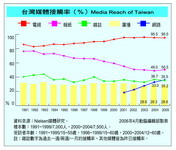Magazine and radio advertising revenues showed low single-digit growth for the year, while internet and mobile (cell phone) advertising increased by more than 50%. Growth was particularly strong in the internet area, which has stood out in the recent period of lackluster economic growth.
The above trends show that man of Taiwan's major media may have seen their best days while other new media are on the rise. Brain Magazine's 2005 statistics for advertising spending in Taiwan showed a total of NT$2.94 billion, just behind the NT$2.97 billion taken in by radio during the year.
A.C Nielsen's 2005 media survey showed a previous-day contact rate of 35.5% for the internet, which ranked third among all media in the survey. This was far ahead of the 28.6% for radio and even edged out magazines, which were at 35.2%. Newspapers, which enjoyed a readership rate as high as 76.3% in 1991, slipped to 50.5% last year while television viewer ratings have not shown any growth for the past two years.
Looking at the overall advertising industry in 2005, advertising expenditure rose by 4.7% over 2004's NT$89.9 billion to reach NT$94.2 billion in 2005. This growth rate was less than half of the 10.03% achieved between 2003 and 2004.
Other media showing growth in advertising were newspaper inserts and outdoor advertising, which registered increases of more than 10% over the previous year. The remaining traditional media all showed marked increases in advertising revenues, with most of them around 5% in growth.
Changing patterns in consumer contact with the media have impacted the way that advertisers are choosing their media buys these days. A glance at Rainmaker's list of the Top 500 Advertisers in Taiwan for 2005 shows that among the top ten advertisers, with the exception of Metropolitan Construction, which achieved a whopping 725% increase in ad spending over the previous year, the average change in advertising expenditures on television, newspapers, magazines and radio from the previous years was a decline of 6.72%.
Raymond Su, Vice-president of Taiwan's largest advertiser, Procter & Gamble, notes that the overall ad spending of many advertisers has not necessarily declined, it has simply been channeled into more non-traditional types of media. With a gradual weakening in the power of traditional media, advertisers have shifted their ad dollars toward the internet, outdoor advertising and other media which offer denser concentrations of consumers.
At the same time there have been a number of changes in the amount spent on advertising by various industries. For example, ad spending by financial institutions and credit card companies declined from NT$4.03 billion in 2004 to NT$3.34 billion in 2005, an eye-catching drop of 17.13%. One key reason for the fall was government curbs on issuance of credit cards and debit cards in 2005. At one point in May last year there was a brief ban on TV advertising for credit cards, a move which put severe constraints on the level of advertising spending by financial institutions.
These non-beneficial factors have led all kinds of media companies to look to outside sources for capital, using their own resources to provide more added value for their clients as they wait for payments from clients. For these media holding special events has become an accepted part of doing business on behalf of the client.
Advertising is no longer simply a matter purchasing space in the print media or buying spots on TV and radio. The media agencies are regularly expected to provide advertising, editing and event marketing services as well as other specialized know-how in order to win bids from the advertisers.
Sometimes an agreement may be reached on a special campaign before agreeing on regular advertising campaigns that will generate profits for the media. The media has little choice but to devote manpower and resources in helping the client to organize special events.
Last year the United Daily News collaborated with China Motors - Mitsubishi on a special campaign to launch the Zinger in Taiwan. In addition to providing newspaper advertising space and editing services, UDN also used the plaza in front of its main office building to set up an outdoor display for the new Zinger model to exploit the large pedestrian and vehicle traffic in that section of Chunghsiao East Road.
Devoting all of one's resources in order to provide more added value to the client is not limited to any one segment of the media.
At the end of 2005 the China Times Group bought the 'three Chinas' from the KMT: China Television, Broadcasting Corporation of China, and China Motion Picture Company. This purchase put the China Times Group astride a wide range of media including newspapers, television, radio, internet, movies and other mainstream media. In the future the number of cross-media campaigns being offered clients by such multi-media organizations is certain to continue increasing.
A similar situation is developing in the explosive inrush of internet media. One company, Yahoo! Kimo, has managed to garner over half of all internet advertising revenues in Taiwan, leaving the rest of the industry to scramble after the remaining half by trying to come up with service schemes that will set them apart from their rivals.
Actually, the changing government policies and economic conditions generally have only short-term, limited effects on media operations. The real forces in determining how the media and broadcasting will develop in the future are things like breakthroughs in technology. The introduction of the internet and related technology has brought more and more people into play, and traditional media will need to respond by bringing in digitalization, more electronic applications and closer ties to internet media in order to continue growing.
Television and radio stations are busy trying to digitalize their signals, and IPTV represents a new area of future development for television. IPTV brings together communications, television and the internet, allowing subscribers to use cable TV to make phone calls, watch TV and surf the internet, all at significantly reduced rates. This is one of the key applications for future development through digitalization of the home.
The need for digitalization is also being felt in the area of print media - newspapers and magazines. Traditional newspapers all maintain their own news pages on the internet. These are liked to other home pages to provide more new content and attract readers from other parts of the internet. For magazines the biggest challenges now are to digitalize their content, expand their range of services and satisfy readers which want to be able to quickly access items that meet their special needs. For example, the various magazines under the US' Conde Nast masthead all have their own separate web pages, and Elle Magazine has suspended production of the print version of its Elle Girl Magazine to continue as a purely internet publication. In Taiwan, Commonwealth Magazine Group has considered to publishes Tech Vantage online under its masthead after ceasing publication of its print edition at the end of 2005. All editorial work for the print edition was shifted over to the internet operations and the magazine was completely digitalized.
Most magazines in Taiwain do not have enough budget to develope e-magazine. The Industrial Development Board of the Ministry of Education provides special funding to the CITE Publications Group and udn.com, and it also provides assistance to some magazines in developing their businesses and publishing electronic books in order to stay up with the rest of the publishing world. Many magazines are still struggling to find their own identity and business model in the age of digitalization, as they watch for changes in reading habits and the way to get information.
Each of the various media has had its own particular technical problems in matching its operations to the internet phenomenon. These include new areas like portable monitors and broadband applications. In the end, however, the speed and ease offered by internet communications, and the unquenchable thirst of the public for new and interesting materials, mean that the media must continue to adapt and expand. The single more important question for many of Taiwan's media right now is how to use the internet to secure and extend their foothold in Taiwan's media market.
《資料來源:動腦雜誌361期/2006年5月》






